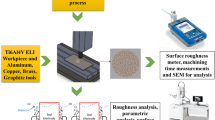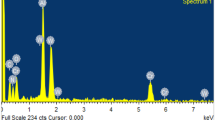Abstract
In view of the difficult machining characteristics of titanium alloys and the limitations of sequential EDM/ECM machining, taking NaNO3 salt solution with low conductivity as the working fluid, the simultaneous machining of EDM and ECM (SEDCM) assisted by abrasive particles was carried out. Firstly, the effects of the electrical conductivity of the working fluid, the abrasive material, and particle size on material removal rate (MRR), tool wear rate (TWR), surface roughness (Ra), and surface morphology of SEDCM were investigated. Then, SiC abrasive with particle size of 50 μm was selected to add in the working fluid of SEDCM, owing to the unique properties of SiC in comparison with Al and Cu abrasive particles. The effect of process parameters, such as peak current, pulse on time, abrasive concentration, and gap voltage, was optimized using Taguchi-based grey relational analysis. The multi-objective optimization of MRR, TWR, and Ra was converted into the optimization of a single grey relational grade. Finally, based on the grey relational grade, the optimal combination of peak current, pulse on time, abrasive concentration, and gap voltage was predicted and verified by experiments. The results show that the comprehensive machining effect is better when the conductivity of working medium is 300 μS/cm, as long as other electrical parameters and experimental conditions are the same. Compared with Cu and Al abrasives, SiC abrasive has the lowest tool wear rate and the best surface quality, even with the worst material removal rate. Moreover, MRR, TWR, and Ra were obviously improved at the optimal parametric combination of peak current 1.5A, pulse on time 15 μs, abrasive concentration 5 g/L, and gap voltage 40 V by implementing Taguchi-based grey relational analysis.







Similar content being viewed by others
Availability of data and materials
All data and materials are available.
Code availability
All software application is available.
References
Pratap T, Patra K (2018) Fabrication of micro-textured surfaces using ball-end micromilling for wettability enhancement of Ti-6Al-4V. J Mater Process Technol 262:168–181. https://doi.org/10.1016/j.jmatprotec.2018.06.035
Sun JZ, Li MQ, Li H (2018) Deformation behavior of tc17 titanium alloy with basketweave microstructure during isothermal compression. J Alloys Compd 730:533–543. https://doi.org/10.1016/j.jallcom.2017.10.001
Yuan S, Lin NM, Zou JJ, Liu ZQ, Wang ZX, Tian LH, Qin L, Zhang HX, Wang ZH, Tang B, Wu YC (2019) Effect of laser surface texturing (LST) on tribological behavior of double glow plasma surface zirconizing coating on Ti6Al4V alloy. Surf Coat Technol 368:97–109. https://doi.org/10.1016/j.surfcoat.2019.04.038
Hu YZ, Meng JB, Luan XS, Dong XJ, Zhou HA, Qu LH, Zhang HW, Wei XT (2021) Plasma electrolytic oxidation of Ti-6Al-4V alloy and its influence on the machinability during micro-milling. Measurement 170:108719. https://doi.org/10.1016/j.measurement.2020.108719
Wang JH, Lyu BH, Jiang L, Shao Q, Deng CB, Zhou YF, Wang JH, Yuan JL (2021) Chemistry enhanced shear thickening polishing of Ti–6Al–4V. Precis Eng 72:59–68. https://doi.org/10.1016/j.precisioneng.2021.04.002
Khalil AK, Yip WS, To S (2022) Theoretical and experimental investigations of magnetic field assisted ultra-precision machining of titanium alloys. J Mater Process Technol 300:117429. https://doi.org/10.1016/j.jmatprotec.2021.117429
Shabgard M, Khosrozadeh B (2017) Investigation of carbon nanotube added dielectric on the surface characteristics and machining performance of Ti–6Al–4V alloy in EDM process. J Manuf Process 25:212–219. https://doi.org/10.1016/j.jmapro.2016.11.016
Zhang Z, Yu HS, Zhang YM, Yang K, Li WY, Chen Z, Zhang GJ (2018) Analysis and optimization of process energy consumption and environmental impact in electrical discharge machining of titanium superalloys. J Clean Prod 198:833–846. https://doi.org/10.1016/j.jclepro.2018.07.053
Chen XZ, Xu ZY, Zhu D, Fang ZD, Zhu D (2016) Experimental research on electrochemical machining of titanium alloy Ti60 for a blisk. Chinese J Aeronaut 29(1):274–282. https://doi.org/10.1016/j.cja.2015.09.010
Skoczypiec S, Ruszaj A (2014) A sequential electrochemical–electrodischarge process for micropart manufacturing. Precis Eng 38:680–690. https://doi.org/10.1016/j.precisioneng.2014.03.007
Li CJ, Zhang BW, Li Y, Tong H, Ding SL, Wang ZQ, Zhao L (2018) Self-adjusting EDM/ecm high speed drilling of film cooling holes. J Mater Process Technol 262:95–103. https://doi.org/10.1016/j.jmatprotec.2018.06.026
Han W, Kunieda M (2021) Research of micro EDM/ECM method in same electrolyte with running wire tool electrode. Precis Eng 70:1–14. https://doi.org/10.1016/j.precisioneng.2021.01.013
Masuzawa T, Sakai S (1987) Quick finishing of WEDM products by ECM using a mate-electrode. CIRP Ann Manuf Technol 36:123–126. https://doi.org/10.1016/S0007-8506(07)62568-2
Ramasawmy H, Blunt L (2002) 3D surface topography assessment of the effect of different electrolytes during electrochemical polishing of EDM surfaces. Int J Mach Tools Manuf 42:567–574. https://doi.org/10.1016/S0890-6955(01)00154-7
Hung JC, Yan BH, Liu HS, Chow HM (2010) Micro-hole machining using micro-EDM combined with electropolishing. J Micromech Microeng 16(8):1480. https://doi.org/10.1088/0960-1317/16/8/007
Chung DK, Lee KH, Jeong J, Chu CN (2014) Machining characteristics on electrochemical finish combined with micro EDM using deionized water. Int J Precis Eng Man 15:1785–1791. https://doi.org/10.1007/s12541-014-0530-7
Nguyen MD, Rahman M, Wong YS (2012) Simultaneous micro-EDM and micro-ECM in low-resistivity deionized water. Int J Mach Tools Manuf 54–55:55–65. https://doi.org/10.1016/j.ijmachtools.2011.11.005
Zhang Y, Xu ZY, Zhu Y, Zhu D (2016) Effect of tube-electrode inner structure on machining performance in tube-electrode high-speed electrochemical discharge drilling. J Mater Process Technol 231:38–49. https://doi.org/10.1016/j.jmatprotec.2015.12.012
Sun SF, Ji SM, Tan DP, Xue W, Wu X (2012) Abrasive assisted EDM & ECM compound machining. J Mech Eng 48(17):159–164. https://doi.org/10.3901/JME.2012.17.159
Xu ZY, Zhang CY (2018) Fabrication of small hole based on EDM & ECM hybrid machining method. Aeronaut Manuf Technol 61(03): 16–22. https://doi.org/10.16080/j.issn1671-833x.2018.03.016
Tang L, Feng X, Huang TQ, Liu J, Zhang JJ, Lei QB, Wang Z (2019) Research on the combined electrochemical machining and electrical discharge machining technology for closed integer impeller. Int J Adv Manuf Technol 102:3419–3429. https://doi.org/10.1007/s00170-018-03231-7
Tzeng YF, Chen FC (2001) Effects of powder characteristics on electrodischarge machining efficiency. Int J Adv Manuf Technol 17:586–592. https://doi.org/10.1007/s001700170142
Marashi H, Jafarlou DM, Sarahn A, Hamdi M (2016) State of the art in powder mixed dielectric for EDM applications. Precis Eng 46:11–13. https://doi.org/10.1016/j.precisioneng.2016.05.010
Tzeng YF, Chen FC (2005) Investigation into some surface characteristics of electrical discharge machined SKD-11 using powder-suspension dielectric oil. J Mater Process Technol 170:385–391
Sahu SK, Jadam T, Datta S, Nandi G (2018) Effect of using SiC powder-added dielectric media during electrodischarge machining of Inconel 718 superalloys. J Braz Soc Mech Sci 40:330. https://doi.org/10.1007/s40430-018-1257-7
Jadam T, Sahu SK, Datta S, Masanta M (2019) EDM performance of Inconel 718 superalloy: application of multi-walled carbon nanotube (MWCNT) added dielectric media. J Braz Soc Mech Sci 40:330. https://doi.org/10.1007/s40430-019-1813-9
Li M, Yu TB, Yang L, Li HY, Zhang RC, Wang WS (2019) Parameter optimization during minimum quantity lubrication milling of TC4 alloy with graphene-dispersed vegetable-oil-based cutting fluid. J CLEAN PROD 209:1508–1522. https://doi.org/10.1016/j.jclepro.2018.11.147
Mhuammd H, Wasim A, Salman H, Mirza J, Abdul HS (2019) Investigating the effects of electric discharge machining parameters on material removal rate and surface roughness on AISI D2 steel using RSM-GRA integrated approach. Int J Adv Manuf Technol 101:1255–1265. https://doi.org/10.1007/s00170-018-3019-1
Acknowledgements
The authors would like to acknowledge the editors and the anonymous referees for their insightful comments.
Funding
This work was supported by the Natural Science Foundation of Shandong Province (ZR2021ME159), and the Open Research Fund Program of Shandong Provincial Key Laboratory of Precision Manufacturing and Non-traditional Machining.
Author information
Authors and Affiliations
Contributions
Jianbing Meng: conceptualization, writing original draft. Shuaike Wang: conceptualization, writing review and editing, project administration. Qingyi Guan: methodology. Xiaojuan Dong: data curation. Hongmei Li: investigation. Li Li: supervision. Guoyong Zhao: project administration. Yugang Zhao: supervision.
Corresponding author
Ethics declarations
Ethics approval
Not applicable.
Consent to participate
Not applicable.
Consent for publication
We confirm that this work is original and has not been published elsewhere, nor is currently under consideration for publication elsewhere. All the authors listed have agreed to publish the manuscript that is enclosed.
Conflict of interest
The authors declare no competing interests.
Additional information
Publisher's Note
Springer Nature remains neutral with regard to jurisdictional claims in published maps and institutional affiliations.
Rights and permissions
Springer Nature or its licensor holds exclusive rights to this article under a publishing agreement with the author(s) or other rightsholder(s); author self-archiving of the accepted manuscript version of this article is solely governed by the terms of such publishing agreement and applicable law.
About this article
Cite this article
Meng, J., Wang, S., Guan, Q. et al. Experimental investigation on simultaneous machining of EDM and ECM of Ti6Al4V with different abrasive materials and particle sizes. Int J Adv Manuf Technol 122, 2307–2317 (2022). https://doi.org/10.1007/s00170-022-10020-w
Received:
Accepted:
Published:
Issue Date:
DOI: https://doi.org/10.1007/s00170-022-10020-w




